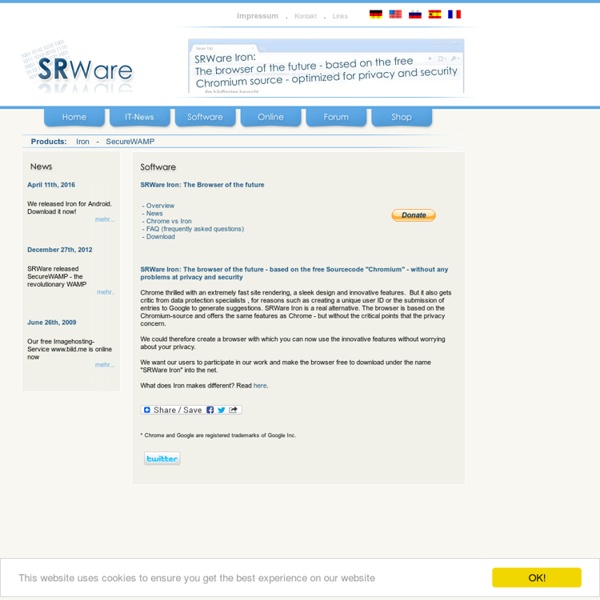Consumentenbond - HDD Erase Methods
Je harde schijf wissen, hoe doe je dat grondig? Computerdata vernietig je niet door op [Delete] te drukken en vervolgens de prullenbak te legen. Dat kan alleen door de gedelete bestanden op de harde schijf te overschrijven met nieuwe data. De eerste twee mogelijkheden zijn het grondigst, want die wissen de gehele harde schijf, maar ook het lastigst. Bij optie 4 laat je het besturingssysteem staan, bij de andere drie heb je de originele installatieschijven nodig als je het oude besturingssysteem er naderhand weer op wilt zetten. Optie 1: volledig formatteren Voor: Windows Vista en 7Hoe: Volledig formatteren (alle data overschrijven)Nodig: Installatie-dvdEenvoudig? Stop de installatie-dvd in de speler en herstart de computer vanaf de dvd. Optie 2: harde schijf wissen Voor: Windows, Mac, LinuxNodig: Gratis software en installatie-dvdEenvoudig? Windows XP-gebruikers kunnen de harde schijf wissen met het gratis Darik's Boot and Nuke. Optie 3: Windows herinstalleren en data wissen
Pismo Technic Inc. - Download
Use of the software available here is subject to acceptance of the relevent license agreement(s). Pismo File Mount Audit Package build 172 Mount ZIP, ISO, CISO, CFS, and PFO files as virtual folders in the Windows file system. Pismo File Mount Core Package build 172 The following PFM core packages are intended for use by software developers in conjunction with the Pismo File Mount Developer Kit. Pismo File Mount Developer Kit build 171 Documentation, headers, and sample code, to allow developers to write extensions to the Pismo File Mount Audit Package or to utilize Pismo File Mount in other applications. Ptiso, ISO/CFS Tool build 171 Command line and GUI tool to create CFS compliant image files and to convert between various CD/DVD image formats. Pismo Trace Monitor build 166 A developer tool that facilitates efficient diagnostic traces, for use during development or for troubleshooting field issues. Previous releases of Pismo Technic Inc. software are available in the Download Archive.
PeerBlock – Peerblock Site
7 Windows Explorer Addons for Power Users
Windows Explorer probably lacks a few features that some people desperately require. It might be quite OK to use for the usual purposes, but when it comes to power tasks, it fails. Here are seven carefully hand-picked utilities that enhance the default Windows Explorer functions and will leave you thinking “Why doesn’t Explorer have these by default?” 1. Windows Explorer, by default, doesn’t show the size of the folder when you opt for the ‘Details’ view. Well, this is when Folder Size comes in as a handy tool that adds the ‘Folder Size’ column to Windows Explorer Details View. Download FolderSize 2. QT Tab Bar brings tabbed navigation to Windows Explorer. Once installed, re-login to Windows, open Windows explorer, right click on the toolbar and check QT Tab Bar and QT Standard Buttons to activate the tabbed interface. Download QT Tab Bar 3. Makes the Windows Explorer File/Folder tooltips to display more information than you can imagine about the selected item. Download InfoTag Magic 4. 5.
pdaConverter v1.37
Description: pdaConverter simplifies the creation of documents for PalmOS based handhelds and works only under MS Windows. The daily synchronisation of webpages/channels can be done, too. pdaConverter supports the following filetypes: jpg, gif, png, pdf, html, rtf, hlp, wpd, txt, Aportis Doc And can produce these filetypes: Plucker, Aportis Doc, zTXT. Update Description: v1.3: Reviews: Write a review
Bandwidth meter - Free bandwidth monitoring software
Simple to use bandwidth monitoring software to track Internet bandwidth usage. It remains in tray and displays the bandwidth usage in current session, day and month. This will be helpful for those with limited bandwidth broadband/adsl connection. Features Option to make meter always visible.Transparency of meter can be adjusted.Option to exclude bandwidth during certain period of day (for those having free usage periods).Download ShaPlus Bandwidth Meter 1.4 (117 KB) Last updated : 14 Apr 2013 (Version history) Cnet.com review of this software (Also explains which network interface to choose in settings) : you can also download from Cnet Download.com If you find this useful, please consider making a donation. Screen Shot



